Elimination of the Baltic "Energy Island" and its Importance for Further EU Market Integration in Sector of the Electric Energy
on
Elimination of the Baltic "Energy Island" and its Importance for Further EU Market Integration in Sector of the Electric Energy
The Baltic States - Estonia, Latvia and Lithuania, in terms of energy infrastructure are frequently referred to as an 'energy island'- the region having very few interconnection routes with the rest of the European Union (EU). As for natural gas, the three states are fully dependent on one third country supply source - the Russian Federation, and a single supply route - a pipeline natural gas transmission network linking Latvia and Estonia directly with Russia, and Lithuania with Russia via Belarus. For electric energy transmission systems, the situation is pretty much the same - they are working in a parallel synchronized regime with IPS/UPS countries within the power loop of Belarus, Russia, Estonia, Latvia and Lithuania (BRELL). BRELL is an agreement signed by above mentioned parties on February 7, 2001, which regulates the operational control over the electric power systems of five the countries.
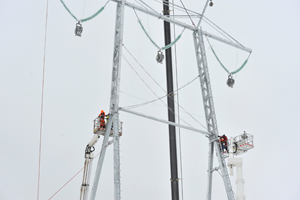 |
| Estlink 2 - source: fingrid.fi |
The Baltic States are linked to the BRELL area of IPS/UPS via twelve 330kV high voltage power lines - most of them connecting Lithuania and Belarus. At the same time, there are only two electric energy interconnectors - submarine 330/400kV HVDC cables - between the Baltic and the rest of the European Union in place, they connect the Estonian and Finnish transmission grids, and are used only for commercial purposes (Picture 1).
Therefore for the elimination of the so called Baltic energy island and further physical integration of the Baltic - Nordic and the Baltic – and continental European energy infrastructure, as well as harmonization of energy markets in said regions to take place, an extensive enhancement of the Baltic transmission grid integrity is required both internally - between Estonia, Latvia and Lithuania - and externally: the three states and their EU neighbours. Also, the topical question of changing the synchronization area of the Baltic States from IPS/UPS to continental Europe should be reviewed in this context, keeping in mind that recently finished studies – particularly a research done by the Swedish consultant company Gothia Power, confirm it is technically possible to realize such a transition.
The summarizing conclusion to be drawn here is that the elimination of the Baltic energy island includes three priorities - firstly, enhancement of the regional grids between the three counties, secondly, realization of interconnection projects linking the Baltic with the rest of the EU, and, thirdly, examination of the possible change of the synchronization area from IPS/UPS to continental Europe.
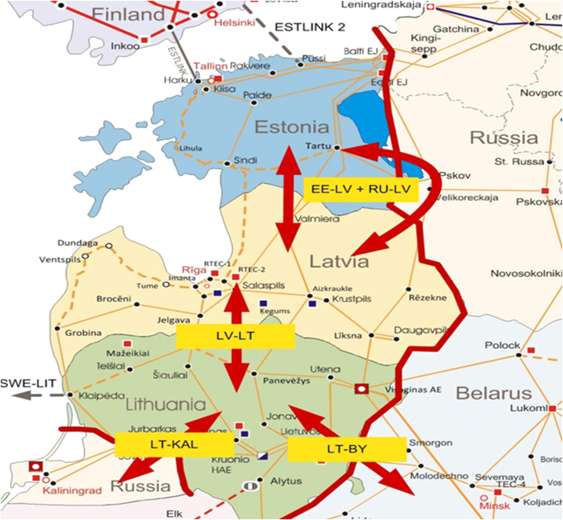 |
| Picture 1: The existing and prospective Baltic PS interconnections (internal and external). |
Additionally, the domestic base load generation capacity issue must not be forgotten or neglected, as the market driven electric energy price formation factors in the Baltic - Nordic region could seriously impact the development and enhancement of the base load generation in the Baltic.
| advanced cross-border interconnections alone, without competitive base load generation cannot be regarded as guarantee for sustainable and stable development of the Baltic electric energy systems as a whole |
The modernization of the Baltic power system interconnections
The enhancement and modernization of the transmission system (TS) interconnections within the Baltic States is one of the crucial factors for true elimination of the energy island in the electric energy sector. That is the main reason why all large scale national and regional energy infrastructure enhancement projects are included in the EU’s Projects of Common Interest (PCI) scope.
Currently, the Baltic power transmission systems are divided into two segments: Estonia on one side and Latvia and Lithuania on the other due to the bottleneck on the Latvian–Estonian border. The transmission capacity of two 330 kV high voltage power lines connecting two countries is insufficient for massive bi–directional power flows, with serious problems being experienced during the hot weather season in the summer period.
After shutdown of the second reactor of the Ignalina nuclear power plant in Lithuania, which took place on December 31, 2009, this Baltic country – for decades being a stable and reliable supplier of fairly cheap energy resources, has become an intensive electric energy importer, receiving about 80% of electricity from abroad. Therefore, TSs of Estonia and Latvia are put under the stress, as they must provide the transit of extra power capacities daily for meeting the Lithuanian electric energy demand.
The capacity of the Latvian – Lithuanian interconnections is sufficient.
| the Baltic countries and Lithuania in particular are not experiencing acute technical shortages in terms of installed base load capacities - the main problem here is an energy price from different base load power plant types |
Two feasibility studies on the project were carried out in 2009 – 'Selection of alternative rights-of-way for Harku-Sindi-Riga 330 kV overhead lines', prepared by Ramboll and 'Economic and Technical Research of the Harku-Sindi-Riga 330 kV Line'. Additional studies on the project’s technical feasibility and prospective energy market integration benefits were performed in 2011 and 2013 by the Latvian and Estonian transmission system operators (TSOs) as well.
It is expected that double circuit 330 and 110 kV overhead lines will connect Riga CHP–2 in Latvia to Kilingi–Nõmme in Estonia. As part of the project, new 330kV substation will be built in Kilingi–Nõmme and reconstruction of 330kV of Riga CHP–2 will be carried out as well. Also the reconstruction of 110kV substations and leadings are planned as a part of the third interconnection between the Latvian and Estonian project.
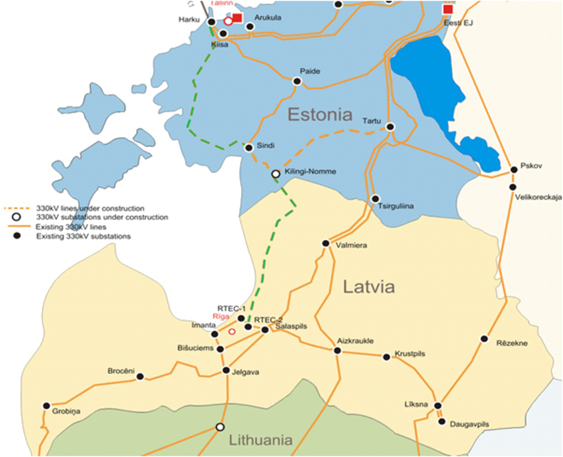 |
| Picture 2: The route of the third Latvian – Estonian PS interconnection. |
The tendering procedures are due January – December next year, with a projected construction period from January 2017 to November 2020. Project’s estimated capital costs are around 112 million EUR shared disproportionally between Latvia (approximately 102 million EUR) and Estonia (approximately 9 million EUR; Picture 2).
When talking about the third interconnection between the Latvia and Estonia, the so called 'Kurzeme Ring'– enhancement of the high voltage grid in the Western part of Latvia (Kurzeme) must be mentioned, too. It is currently in an active stage of realization, and includes three phases. The first phase has already been finalized in 2013, when the 330kV ring around Riga was closed, the second phase – reconstruction of power transmission grid between Grobiòa and Ventspils is on its way. The third phase, however, including construction of power lines between Tume and substation of CHP 'Imanta' in Riga is planned to be commissioned only in 2018 (Picture 3).
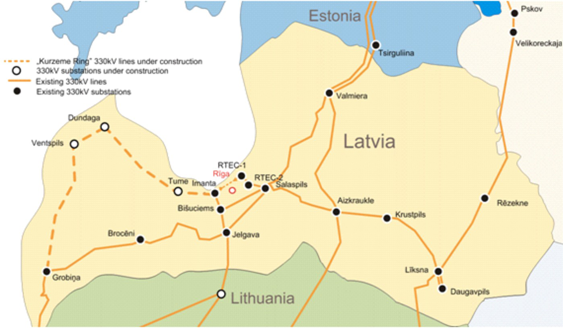 |
| Picture 3: source: ast.lv |
The Kurzeme Ring project will not only benefit the modernization of the existing Latvian transmission grid a lot, but will also provide a technical possibility to integrate large wind power generation capacities of up to 400MW into the Latvian transmission system, and boost a diversification of the power generation from renewable energy sources in the Baltic.
The project costs for phases one and two are 66 million EUR and 127,4 million EUR for phase three.
Enhancement of the power transmission capacities between the Baltic and the rest of the EU
As per 2014 the Baltic electric energy transmission systems’ only two non–BRELL interconnections are marine 330/400kV HVDC cables Estlink I and II linking Finland and Estonia stretching across the Finnish Gulf, with total power transmission capacity of 1000MW (for Estlink I – 350MW, commissioned on January 5, 2007, and Estlink II – 650MW, commissioned in March 2014).
Estlink I connects Harku on the Estonian side and Espoo on the Finnish one, while Estlink II – connects Puusi and Antilla in Estonia and Finland respectively ( Picture 4).
 |
| Picture 4: Source: elering.ee |
However, the transmission capacity of the Estlink interconnections is not fully sufficient
| only in the Estonian and Finnish price areas of Nord Pool Spot electric energy exchange, the prices of electric energy have been almost harmonized |
Latvia and Estonia are interconnected only by two 300kV high voltage power lines, and their transmission capacity is too small for an intensive electric energy flow between Lithuania and Latvia from one side and Estonia and Finland from the other.
In order to connect the Baltic and Nordic regions in the South, several route options were analyzed. At the beginning, both the Latvian and Lithuanian routes were under review, until the principal decision was made in favor of the Lithuanian one. The Lithuanian – Swedish power system interconnection NordBalt – a 350km long marine 330/400kV HVDC cable with transmission capacity of 700MW linking Klaipeda in Lithuania and Nybo in Sweden is due to be commissioned in 2016 (Picture 5).
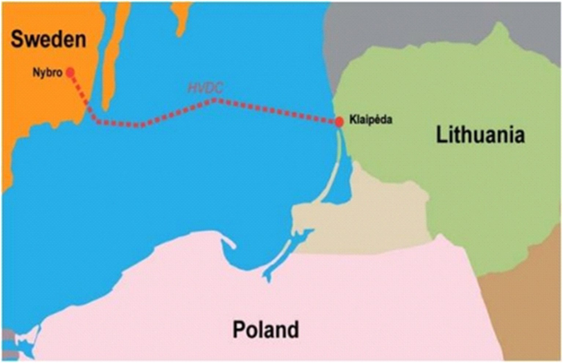 |
| Picture 5: Source: geografija.lt |
The estimated costs for the realization of NordBalt project are about 580 million EUR, with 270 million EUR for the cable costs alone.
The TSs interconnector between Poland and Lithuania LitPolLink will be the only energy bridge between the Baltic and continental Europe. It will connect the Kruonis pumped storage plant in Lithuania with Narew in Poland, and its length on the Lithuanian side will be 101 km, and on the Polish side 240 km. The interconnector’s HVDC back-to-back station containing two 500MW converters will be located in Alytus, Lithuania (Picture 6).
The total transmission capacity of LitPolLink will reach 1000MW, and the first phase of the project with a transmission capacity of 500MW will be put in operation in 2015.
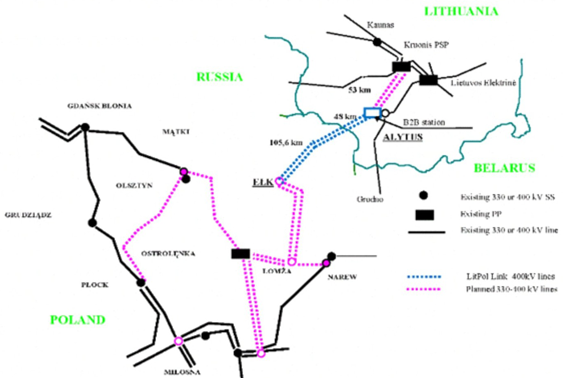 |
| Picture 6 |
“Augstsprieguma tîkls” of Latvia, “Elering” of Estonia and “Litgrid” of Lithuania- signed an agreement to study the technical and financial feasibility of the Baltic grids’ synchronicity change.
| the study concluded that synchronicity area change is technically possible |
The study showed three prospective synchronicity change scenarios (scenario A and scenarios Ba and Bb), all of them having their pros and cons. One of the problems highlighted in all scenarios was the situation in the exclave of the Russian Federation – the Kaliningrad region, which electric energy transmission network does not share any connections with mainland Russia or Belarus, but is historically integrated into the Baltic TSs due to its geographical location.
Scenario A says that the Baltic States might keep their present synchronization area, being linked to Nordic and Central Europe via DC interconnections only. This scenario has a significant benefit, as no bulk investments into the enhancement of existing power transmission grids are required. Even today the system balancing and frequency regulation is still performed by Russia, so nothing significant would change in this matter according to scenario A. However, the development trends of BRELL and base load generation capacities in the BRELL region are quite unclear. Moreover, the dependence on Russian energy supplies, system balancing and frequency regulation would remain, and problems would arise with the implementation of the Third Energy Package – namely, rules of the EU grid code adoption in Russia and Belarus.
Scenario B, in turn, foresees synchronization of the Baltic States with the continental Europe, being linked to BRELL via DC interconnections for trade. Scenario B has two variations – firstly, synchronization of the Baltic States with continental Europe including the Kaliningrad region (scenario Ba and, secondly, synchronization of the Baltic States with continental Europe excluding Kaliningrad region (scenario Bb). In both cases dependence on third countries will be minimized, but at the same time, large investment will be needed in order to enhance existing Baltic TSs and build new interconnections with the continental Europe (Poland). The emergency reserves of the TSs will need to be increased significantly along with addressing the frequency balancing problem. Additional complicated legal issues and financial consequences should be expected by the Baltic as the result of a breach of the BRELL agreement. In case of variation Bb of the B scenario, the status of the Kaliningrad region and its security of supply solutions will require special clarification prior to its desynchronization with the Baltic grids can be legally approved and technically realized.
The estimated costs of the synchronization area change for three Baltic States (excluding costs for Russia and Poland) would be about 122 million EUR in case of scenario A, and 435 and 622 million EUR in case of scenarios Ba and Bb respectively.


Discussion (0 comments)